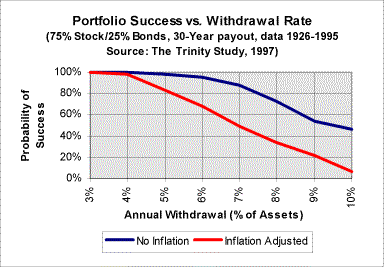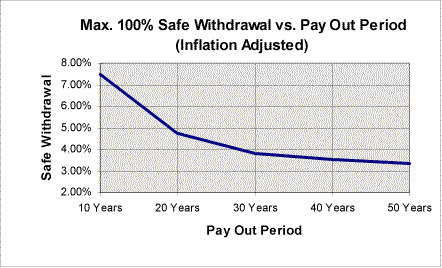Retirement Investing: Withdrawal Rates
. . . or, how much will I need, and what kind of income can I safely expect from my investment portfolio?
For those who may be new to this area of investment planning ... M*'s Olivia Barbee explains that "withdrawal rate refers to the percentage of your total portfolio that you spend each year. If you have a portfolio that's worth $100,000 and you withdraw $5,000, then you have a withdrawal rate of 5%. It doesn't matter whether that spending money comes from income or capital gains." (Investing for Retirement, Conversation #1487)
Unfortunately, not every investor is going to be able to retire with a portfolio that can provide sufficient income to meet their current and future needs. When this happens, they will likely need to draw upon principal from their investment portfolio, in addition to using the interest, dividend, and capital gains income it generates, to meet their expenses. It is this situation with which we are most concerned here: when the necessary withdrawal rate to meet our living expenses is such that we are drawing down the principal balance of our portfolio, and hoping that we don't outlive our assets.
The factors weighing into whether or not our assets will likely be sufficient are many, and the effects of both inflation and less-than-expected investment returns can dramatically impact the retirement plan. Nonetheless, based upon substantial historical data, some meaningful assessments and projections have been made by various researchers and analysts which offer some general guidelines to investors holding well-diversified portfolios with varying allocations between stocks and bonds.
From the well-known Trinity Study, we are able to determine what might be reasonable for an investor to expect his or her likelihood of having sufficient assets to be, as well as what would be a "safe" withdrawal rate. The chart below reflects these probabilities, based upon historical rates of investment return for a 75/25 stock/bond portfolio. A second line on the graph reflects the additional impact of inflation, again calculated on the basis of historical data:
 Using this chart, we can estimate how much can be withdrawn each year with some acceptable level of probability of not running out of money before the end of 30 years; or, used in reverse, approximately how much would need to be saved and invested in order to be able to withdraw sufficient money to meet expenses. For example, an investor with a $200,000 portfolio and wishing to accept no less than an 80% likelihood of not exhausting his or her investments in 30 years, could comfortably work with a 5% withdrawal rate -- which would give them a pay out of $10,000/year.
Using this chart, we can estimate how much can be withdrawn each year with some acceptable level of probability of not running out of money before the end of 30 years; or, used in reverse, approximately how much would need to be saved and invested in order to be able to withdraw sufficient money to meet expenses. For example, an investor with a $200,000 portfolio and wishing to accept no less than an 80% likelihood of not exhausting his or her investments in 30 years, could comfortably work with a 5% withdrawal rate -- which would give them a pay out of $10,000/year.
Similarly, a younger investor, still building their retirement portfolio, can deduce from the chart that a conservative or "safe" withdrawal rate of 4% to 5% means they will need their portfolio to be about 20 to 25 times however much they expect to have to withdraw from it each year, again assuming here a 30 year retirement period. So, if you think you'll need $45,000/year during retirement from your investments, in addition to Social Security or any pension or retirement income you'll receive, this study suggests that you'll need somewhere between $900,000 and $1.125 million invested, in order to be relatively "safe" in your retirement.
Interested in what the safe withdrawal rate would be, depending upon how long your retirement lasts? Here's what research indicates:

Source: The Retire Early Home Page (see link, below)
I've been feeling a bit less secure about my own early retirement since studying this one, I must confess, and perhaps have now an even better attitude about the little bit of part-time work I still do. But at least I'm starting to put together the right tools with which to attack the problem.
An important thing to remember when working with these calculations is that taxes you will be paying on interest, dividend, capital gains, and perhaps other income as well, should be included when determining your needed withdrawal amount; after all, taxes are an expense, like any other. If all of your assets happened to be in a Roth IRA, this wouldn't be a factor to be concerned with, but for most of us, it will. Taxes on distributions from a regular, non-Roth IRA, which are taxed as regular income, as well as taxes on investment income from your taxable portfolio, thus should be included in your withdrawal amount, and your withdrawal rate adjusted accordingly. Investors with income from other retirement plans or trusts may have additional tax considerations as well, so there may be a variety of factors to be considered and weighed.
Two further considerations that will probably come to mind for many at this point are:
- Just how "safe" is a 4%-5% (or any other) withdrawal rate?; and,
- What effect will my asset allocation have on all of this?
In response to these questions, I would like to refer you to two web pages:
What's the "safe" withdrawal rate in retirement? - an excellent article giving a brief overview of the studies pertaining to retirement investing and withdrawal rates, and which explains in more detail the probabilities or likelihood of success associated with these withdrawal rate recommendations
A Caution About High Withdrawal Rates In Retirement - column written by Scott Burns, discussing safe withdrawal rates, and providing a safe withdrawal rate comparison for portfolios utilizing different stock/bond allocations
Of course, this is only a very cursory introduction to this subject, and as is the case with everything in the world of investing, much controversy and discussion abounds. What has been presented here is typical of the kind of valuable information to be found, but is by no means conclusive, and hopefully will encourage everyone to dig deeper into all of this for themselves.
While researching this, I discovered that there are many useful resources on the internet concerning these subjects. Recalling what the state-of-the-art was twenty years ago in the financial and retirement planning fields, we have come a very, very long way indeed. Below, I have tried to provide some additional links and references, and hope some of this may prove interesting and useful to others. And, again, I hope you will all feel free to jump in and contribute, and help make this a good little retirement planning resource for both new and old Vanguard Diehards alike.
Other retirement planning and investment references, articles, and links:
The Trinity Study - article by Scott Burns
Retirement Savings: Choosing a Withdrawal Rate That Is Sustainable - article from the AAII Journal, written by three principals of the Trinity Study
Retire Early Home Page - this is a great page, and it's where I first found the nice charts, above. MS Excel/Win9x users can download software to calculate your own safe withdrawal rates.
Can You Afford Retirement? - the first in a multi-part article from the Vanguard Learning Center
Jaye C. Jarrett Home Page - the stated objective of this site is to "offer insight on retirement withdrawals and other spending agendas. Our mission is to provide as much useful information as possible regarding efficient investment and withdrawal strategies."
M* Investing DURING Retirement, Conversation #208 - an interesting discussion of withdrawal rates
How Much Can You Safely Withdraw for Retirement? - as the name suggests
The Retirement Calculator from Hell - William J. Bernstein gets into some of the finer points and pitfalls of popular retirement planning calculators
All text and comments placed into the public domain. Displayed graphics may be copyrighted or otherwise protected; please refer to graphic link addresses:
First chart, above, at: http://www.tfnb.com/MORTGAGE/test/trin1.gif
Second chart at: http://www.geocities.com/WallStreet/8257/re50gif2.gif